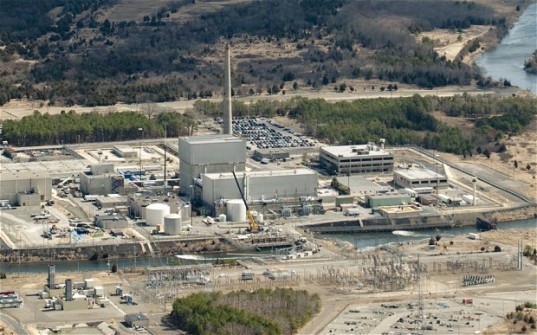
STAFFORD – The Nuclear Regulatory Commission said that the Oyster Creek Generating Station operated safely in the last year, during an annual meeting to address safety with the public.
The meeting was held by the NRC at the Holiday Inn on Route 72 in Stafford. There were about 30 people in attendance, but only a handful were not members of the NRC, Oyster Creek staff, or media.
During the course of the very short presentation, the NRC staff mentioned three green findings and two white ones over the course of the year. They did not go into detail on what these issues were, except for the most recent white finding. Washers were not installed and an electromatic valve did not operate correctly. The plant has five, and three are to be running at any given time.

The color-coded findings are created by the NRC to give people an idea of how serious a problem is. Green is the lowest, and signifies a low finding. White is the next highest, which indicates a low-to-moderate finding.
Jeff Brown, who identified himself as a Brick resident and a member of GRAMMES (Grandmothers, Mothers and More for Energy Safety) compared the NRC to an enabler or a “permissive parent” letting the Oyster Creek staff get off light for their mistakes.
He said it undermines the NRC’s credibility that they don’t fine nuclear plants for even the most mundane issues.
He said that technology like a nuclear reactor functions on a “bathtub curve” when it comes to problems. There are a lot in the beginning, then once the plant is operating, there are a low amount of problems, and then it spikes again at the end of its life. Now, the plant is at the end of its life, or “the countdown to the shutdown,” so he expects to see issues pile up.
Additionally, the spent fuel that is stored at the plant needs to find somewhere else to go, he said. No one wants to store this nuclear waste, least of all so close to homes.
Particularly, with a terrorist attack happening in Seaside Heights (when someone made a dirty bomb at a 5K run), it would make Oyster Creek a target.
“This is not theoretical. We’re vulnerable,” he said.
Silas Kennedy, the branch chief of the division of reactor projects for the NRC, reiterated that the plant is operating safely.
“A few failures here and there does not make a plant unsafe,” he said.
David Pelton, deputy director of the division of reactor projects for the NRC, said that there was no reason to fine Oyster Creek when the safety findings were not very serious, particularly because staff responded and got the issues fixed.
Bill White, another local resident, said he was a chief technical engineer at another plant. He said while he is a fan of the nuclear industry, he is glad to see Oyster Creek shutting down.
“An aging plant is not good for the industry and the country,” he said.
He wanted to know about how the coolant systems worked, and seemed satisfied with the answer he was given.

These two residents were the only ones who commented at the meeting. Interestingly, when they questioned Oyster Creek’s safety, Oyster Creek employees did not respond. NRC answered the questions.
“It’s our meeting,” Neil Sheehan, spokesman for the NRC, said after the meeting. “They have an option to answer, but we don’t require them to answer.”
“It’s not our intention to defend” Oyster Creek from criticism, he explained. The responses were factual statements as to the safety features and policies observed by inspectors.
“This is the NRC’s meeting and we welcome this kind of forum,” said Suzanne D’Ambrosio, spokesperson for Exelon, the company that owns Oyster Creek.
“It’s an aging plant. Oyster Creek is 47 years old. It’s always been well maintained. The age is strictly a number,” she said.






